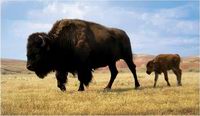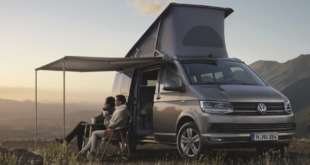Reprinted with permission from ACP Media (Motorhomes and Caravans)
Article by Ted White.
Ted White describes a trip from Denver, Colorado to Wyoming's Yellowstone National Park  Our new truck arrived at the Denver dealer’s yard in mid-July. Ten days later we flew to Denver to take delivery, and spent another 10 days working our way back to Canada via the states of Colorado, Wyoming, Montana, Idaho and Washington.
Our new truck arrived at the Denver dealer’s yard in mid-July. Ten days later we flew to Denver to take delivery, and spent another 10 days working our way back to Canada via the states of Colorado, Wyoming, Montana, Idaho and Washington.
Being mid-summer, the highways were teaming with motorhomes and trailers on their way to or from the Grand Canyon, Mt Rushmore, Grand Teton, Glacier, and Yellowstone National Parks, as well as a host of other interesting destinations in the northwest United States.
It was an opportunity to visit places we had not been to in more than two decades, including Thermopolis and Yellowstone. Before doing so though we decided to spend a few days exploring Denver, the “mile-high city”.
Denver in late July is typically about as hot as Kelowna, with daytime temperatures ranging from the mid 30s to the low 40s, but a big difference is the almost daily thunderstorm activity in the afternoons.
Sightseeing has to be carefully planned to take advantage of the sunny mornings, before the clouds begin to roll in, especially when visiting alpine areas like Mount Evans or Pikes Peak.
Then, once the rain begins later in the day, indoor activities are more appropriate, like a tour of one of the breweries – Coors, Budweiser, or Flying Dog – or a visit to buildings in the historic downtown area.
Of particular interest downtown is the 115-year-old Brown Palace Hotel. Its ornate ironwork atrium offers a unique setting for the daily afternoon tea service and there are displays of silverware and hotel memorabilia going back to the very early days in the history of this Denver landmark.
One of the highlights of our time in Denver was the drive to the end of the highest paved highway in the United States, within a short walk of the peak of Mount Evans at 14,100ft or 4346m above sea level.
It is a spectacular drive, through a series of very different ecological zones, often with precipitous drops on one side of the road and sheer mountain cliffs on the other.
Yellow-chested marmots and mountain sheep are common sights along this road, and the view from the top is amazing, way into the mountains beyond Summit Lake, which, despite its name, is actually more than 200 metres below the highest point.
Closer in towards Denver, in the foothills, tourists flock to Dinosaur Ridge, where petrified footprints and the remains of dinosaur bones from the Jurassic Period can be seen preserved in the rock faces, particularly around Red Rock Canyon, which is a beautiful natural amphitheatre of towering red cliffs.
In more modern times, groups such as the Beatles performed here, and the theatre is fully booked each summer for performances by the well known stars of today.
There are a number of private and state RV parks in and around Denver, each with their own unique characteristics, but our choice of best place to stay would be Chatfield State Park, overlooking Chatfield Lake to the west of the city, with the nearby privately operated Dakota Ridge RV Park coming in second, and Cherry Creek State Park in third place.
We left Denver wishing that we had had more time there – time to visit some of the other well known attractions such as the Georgetown Loop Steam Railway, the Royal Gorge Bridge, Buffalo Herd Nature Preserve, the Celestial Seasonings factory tour, and Forney Museum, where the world’s largest steam locomotive, the “Big Boy”, is on display.
From Denver our route took us a little to the north and then west to Thermopolis in Wyoming, site of the world’s largest hot spring.
Almost 82 million litres of water, at around 55 degrees Celsius, flow from the spring at Thermopolis every 24 hours.
Some is redirected into hot pools at nearby private and state park facilities, but the majority of the water runs across the beautiful natural terraces and into the Wind River.
There is no charge to visit this park, or to use the state hot pools, because of a “free access” agreement made with the local Indians when the land was acquired by the federal government.
The hills above Thermopolis are home to a herd of buffalo. The herd was grazing both sides of the loop road during our visit and we were able to drive slowly through a group of these large animals and their calves.
They are very tolerant of visitors who stay in their vehicles, but each year a number of people ignore the warning notices and are seriously injured when they get out of their cars.
Around 300kms to the northwest of Thermopolis lies Yellowstone National Park, a vast thermal region, almost 150kms by road between the north and south gates, and roughly the same between the west and east gates. In addition to thermal attractions the park is teaming with wildlife.
In fact, it would be an unlucky visitor indeed who did not see at least one bear and several hundred bison during a visit.
There are 13 campgrounds dotted through Yellowstone but in peak periods reservations are essential because there is no freedom camping permitted in the Park and the campgrounds fill up quickly.
A small proportion of the sites, in some of the campgrounds, have full hook-ups, but the majority of sites offer only electricity and access to fresh water, or no services. It therefore pays to be prepared for self sufficiency while RVing in Yellowstone.
There is so much to see here, and the distances between key attractions are so great, that a minimum of three days should be allocated for a visit, although even those three days would give little time to enjoy more than one or two of the many ongoing ranger programs and hikes.
In addition, the seven-day pass which all visitors must buy on entry also gives access to Grand Teton National Park, which connects with Yellowstone at the south gate. Add another couple of days for a quick drive through Grand Teton and it is easy to have a week disappear in these two world famous parks.
Our next article will describe some of the wildlife and attractions in Yellowstone National Park, as well as tracking our route through Montana, Idaho and Washington back to British Columbia.









Join the Discussion
Type out your comment here:
You must be logged in to post a comment.